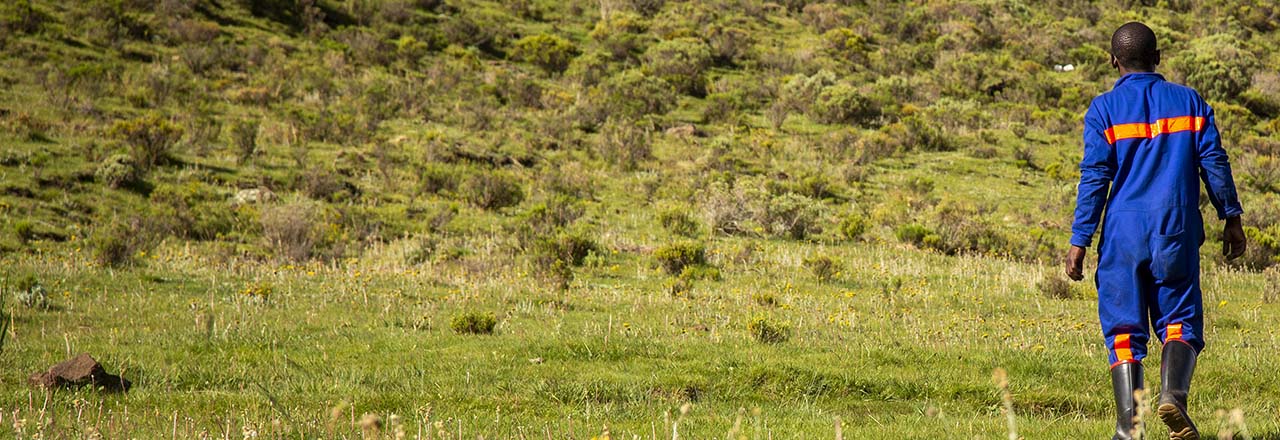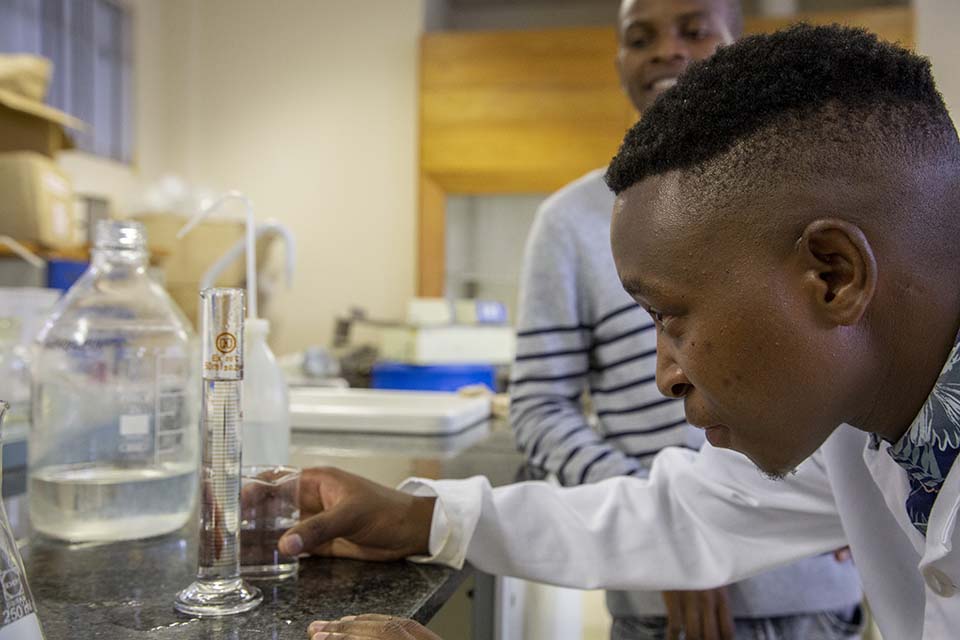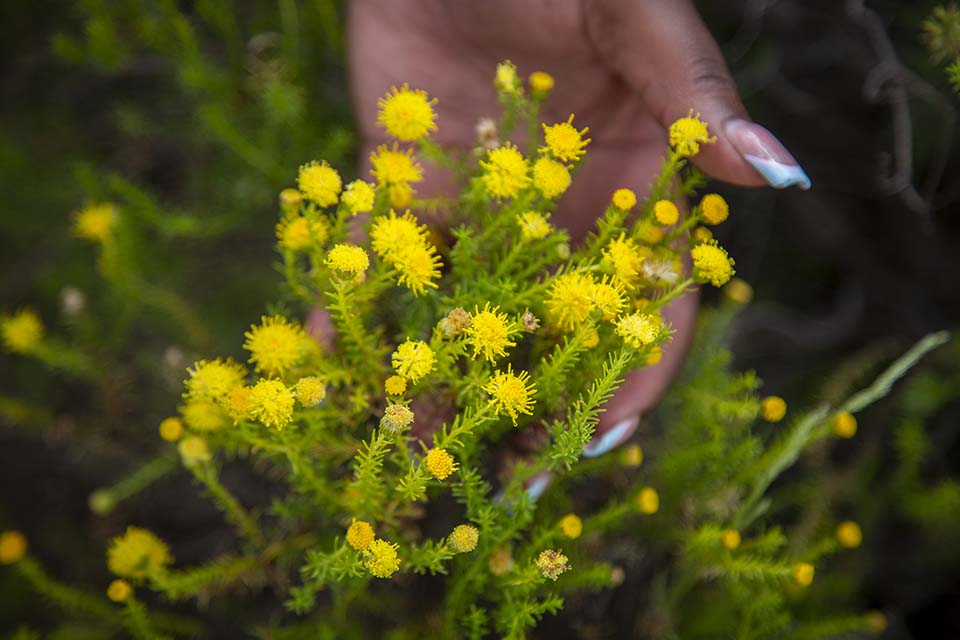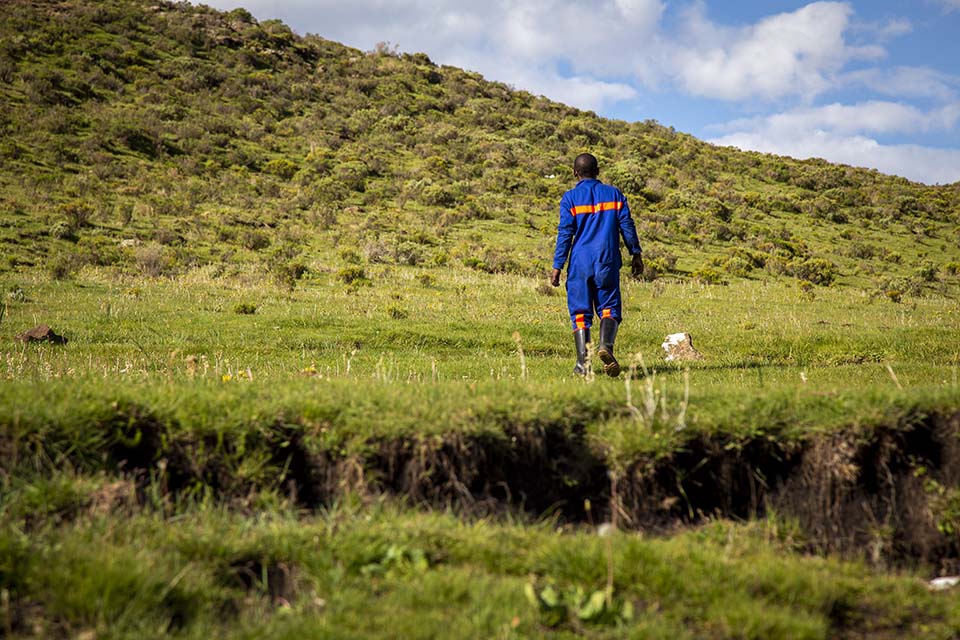

Restoring and Preserving Lesotho’s Rangeland
Thabo Masobeng, a soil scientist at the National University of Lesotho, carefully measures fertile soil into a beaker. He is processing the samples that he and other graduate students gathered earlier in the day.
Soil scientists like Thabo are crucial to ensuring the future of communities in Lesotho. They conduct tests, advise on soil fertility improvement, diagnose plant growth problems and find ways to bring degraded soil back to health over time. Thabo is part of a group of five scientists completing postgraduate Master of Science programs in soil science at the National University of Lesotho. For his postgraduate thesis, Thabo is doing a time series study from 2012 to date to see how land has been used historically and how much the health of the land is being affected by land use.

Graduate soil science student Thabo Masobeng processes soil samples in the laboratory at the National University of Lesotho.
Photo by Dooshima Tsee/CRS
“Carbon is very important to improve soil quality and fertility. However, there is a problem of carbon studies. They are few; it is not easy to do,” Thabo says.
Carbon sequestering is an area of research that several members of this group of five soil scientists are studying. Well-managed soil has a significant potential for carbon storage which improves the fertility of the land over time and combats greenhouse gases, a major driver for climate change.
Understanding the rangelands is a critical prerequisite to finding sustainable solutions to land degradation. Catholic Relief Services, through the Land Restoration Platform, is partnering with National University of Lesotho to support the research of Thabo and four other postgraduate soil scientists. While some research exists, there needs to be more knowledge and understanding of the ecosystem that feeds and sustains the rangelands in Lesotho. In a very real way, scientists like Thabo are the future of farmers, and ultimately, food security in Lesotho. Their research provides the critical data to crack the code of managing and restoring rangelands buffeted by the effects of climate change, land degradation and over-grazing. CRS funding enables this research to continue building on existing research to find the clues to what is working, what is not and the best methods to protect and restore rangelands sustainably.
Protecting soil
“A lot of carbon is being removed from the soil, and the soils are suffering,” explains Dr. Botle Mapeshoane, a soil scientist from the university. “Once there is no carbon in the soil, the nutrients are not reserved. They are just lost. So, they lose their fertility very easily. They are easily eroded. When you till the soil, it’s becoming weaker and weaker every year. So, there is a lot that is being lost from the soil that is very significant,” she says.
Dr. Mapeshoane is a senior lecturer with the Department of Soil Science and Resource Conservation at the university. She has worked in academia, studying soil science and conservation for over 15 years. She started her academic career in agriculture but soon focused on resource management. She supervises the five masters students.
“My work as a soil scientist is to protect soil. To see that people don’t take soil as just dust. Everything comes from the soil. If you don’t see that you are abusing [the soil], at the end of the day, you are the one who is going to suffer if you don’t protect it,” she says.
Invasive species: A threat to productive life in Lesotho’s rangelands
Miles away up in the rangeland, Tatolo Nthoesele, a catchment watershed team treasurer and farmer in Semonkong, uses a pickax to dig out an invasive plant, Felicia filifolia. This plant has become a common sight on mountainsides in the rangelands of Lesotho. Most people who live in rural communities in Lesotho are herders and crop farmers. They depend on healthy rangelands for animal grazing. A very immediate threat to their ability to earn income from herding and farming is the quality of the rangelands.

CRS staff Nthabiseng Makoa holds invasive species, Felicia filifolia, in Maletsunyane, Maseru district, Lesotho. Invasive species are one of the biggest threats to farmers in many rural communities in Lesotho.
Photo by Dooshima Tsee/CRS
“The invasive species have not always been here. They just started growing recently as I am a grown man. When I was growing up, they were never there. But right now, they just started growing in the past years,” Tatolo says.
Over recent decades the rangelands have been degrading, with fewer edible plants for animals to feed on. Invasive plants like Felicia filifolia are taking over the rangelands in Lesotho at an alarming rate. This limits the quantity of livestock that rangelands can support, making all animals on the range more susceptible to droughts and dry spells. Invasive plants grow fast, are hardy and difficult to eradicate. Inedible for livestock, they also choke out the grass that herds graze on and threaten to overtake medicinal plants that are a crucial part of the culture and lives of communities in these rangelands.
CRS works with communities to establish catchment watershed teams of volunteers who mobilize their communities to carry out land restoration activities to improve the rangelands.
“I did not attend school at all. I did not get the opportunity to do the things that most of the people are doing like going to school and then finding a job,” Tatolo says. “The reason I am so interested in protecting the rangelands is because the major income in my home comes from the rangelands. That is my major income and that way I’ll be able to take my children to school. Because I most desire to see my children go to school and achieve what I was not able to achieve.”
Protecting wetlands to serve future generations
At first sight, the wetland area looks unremarkable: an area with grass that is greener than the surrounding vegetation. But as Tatolo walks further, differences become evident. The soil is spongy and soaked through with water. A small trickle flows for several yards at the center of the land before it disappears into the ground. This lush area is teeming with life and critical to the community.

Tatolo Nthoesele inspects a watershed in Maletsunyane, Maseru district, Lesotho. Animal and crop farmers depend on watersheds to provide good quality water for human consumption, support livestock and plants, and ultimately to improve health, nutrition and income for communities.
Photo by Dooshima Tsee/CRS
The wetland covers an area of about 200 yards wide and roughly a quarter of a mile long. Large boulders painted with white paint mark the boundaries of the wetland. Wetlands are large, absorbent areas that retain water and release it slowly during periods of low rainfall and drought, feeding the land around them. Healthy wetlands mean that even during dry spells, streams keep flowing.
Lesotho is considered the “water tower” of Southern Africa. Water is an invaluable resource for the communities in the Orange-Senqu River Basin. These rangelands are also strategically important for the subcontinent. They provide the largest source of freshwater in the region. Preserving these wetlands will have positive ripple effects. Massive dams across Lesotho funnel water exports to South Africa and neighboring countries. But the true source of these water systems starts with the small streams and wetlands across the Orange Senqu River Basin. This underscores the urgency of the wetland preservation work Tatolo and other catchment watershed team members do.
Tatolo and other team members monitor the area daily. They educate nearby communities about the importance of maintaining the wetlands. One thing that could destroy the wetlands is continuous animal grazing.
As Tatalo explains how the catchment watershed team functions, in the distance, some sheep wander into the wetland. Tatalo runs to the herder to ask him to move his sheep elsewhere to graze. It is a hard thing to do—asking herders to keep their animals from feeding in the freshest, greenest spots. One way that Tatalo has helped them adhere to these community rules is by explaining the long-term benefits of healthy wetlands.
Land restoration is a complex process and requires long-term commitment and hard work. CRS, through the Land Restoration Platform project, has fostered a synergy between those who care for the land and researchers. University research feeds directly into solutions to restore the rangelands. Farmers and herders like Tatolo implement those solutions and patiently care for the land. Bringing together indigenous knowledge and passion for the land, and strategic academic research, CRS helps communities in Lesotho care for rangelands and find land restoration solutions.
* * * * * * * * * * * * *
CRS is an implementing partner for the Deutsche Gesellschaft für Internationale Zusammenarbeit GmbH through the Support to Integrated Catchment Management program in Lesotho. The program, also known as ReNOKA, aims to advance environmental protection and adaptation to climate change while improving food security through sustainable water resources. It will also leverage opportunities in the green economy and build on the water‑energy‑food security nexus in Lesotho. Through a partnership, the Government of Lesotho, the European Union and the German Federal Ministry for Economic Cooperation and Development also support ReNOKA. Alongside the catchment project, CRS also implements the land restoration scaling roadmap in Lesotho. The aim of the project is to build evidence on the impact of watershed restoration by analyzing core indicators. The project anchors land restoration program activities by providing support to access communities and leverage relationships with communities and government officials.

